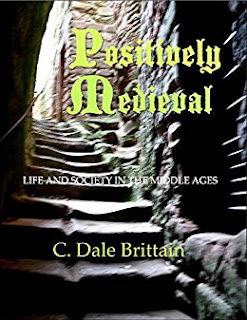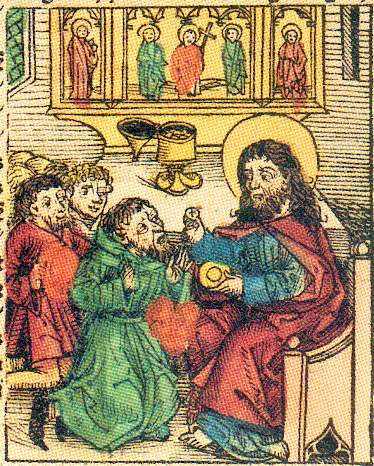This brings us to the White Caps, a religious/social movement of the 1180s. It started in the town of Le Puy, in the Auvergne, a city built on a series of volcanic cones. A man named Durand had a vision of the Virgin, who is the patron saint of Le Puy.

This is the town today. On top of the highest peak you can glimpse a nneteenth-century statue of the Virgin.
Anyway, in Durand's vision in the 1180s he was told to form a group of faithful people who would all adopt a lead badge with the Virgin's image on it and a white cap or hood. Both lords and peasants joined the group, with the goal of bringing "peace" to the region, in part by attacking bandits who were interfering with local trade. Durand's group was known as the capucciati because of their caps.
Several chroniclers recorded the events at the time, all giving slightly different versions. One said that the vision that began it was nothing but an "imposture," and that the greedy merchants of Le Puy just wanted an easier time transporting their goods. Most however credited the group with real religious devotion.
The movement quickly spread north into Burgundy and became established in the region around Auxerre. Here, the chroniclers all agreed, the movement changed, and the peasants and villagers turned on the lords who had once been part of their group, saying they were all bandits themselves. At this point the bishop of Auxerre, recently consecrated, became involved.
Bishop Hugh rode out, heavily armed, with his men and rounded up all the White Caps folks he could find. He took away their caps and their badges, saying they had forgotten that "the wages of sin are servitude" and they were all sinners and serfs, and that the Bible says that serfs should not attack their lords (the Bible actually says "the wages of sin are death" and talked about slaves, not medieval serfs, but this was close enough for the bishop).
He told the defeated White Caps that, to punish them, they would not be able to wear any hat at all for a year, either to shelter them from the bright sun during harvest or to keep the snow off in the winter. The bishop's uncle, the archbishop of Sens, however saw the men roasting in the harvest fields, had pity, and told Bishop Hugh to let them wear regular hats again.
This short-lived revolt has several interesting features. One is that it demonstrates peasant agency, the ability of people who are usually thought of as marginal and oppressed to fight back against oppression, as I have discussed earlier. It also shows that what might be considered a social revolt, an effort by peasants to claim that all lords were, in some form, bandits, would take on a distinctly religious tone in the Middle Ages. The capucciati were not an actual heresy, because they were not espousing erroneous doctrine, but a religious impulse clearly started their movement. It is also important to note that bishops were not always in agreement with each other, and that many bishops, like Bishop Hugh of Auxerre, felt that they were a better judge of real religion than other people, and were prepared for armed conflict to prove it.
© C. Dale Brittain 2020
For more on medieval religion and society, see my ebook, Positively Medieval: Life and Society in the Middle Ages, available on Amazon and other e-tailers. Also available in paperback!
For more on medieval religion and society, see my ebook, Positively Medieval: Life and Society in the Middle Ages, available on Amazon and other e-tailers. Also available in paperback!



![A Long Way 'Til November (The Royal Wizard of Yurt Book 9) by [C. Dale Brittain]](https://m.media-amazon.com/images/I/51jDH1ypWeL.jpg)
